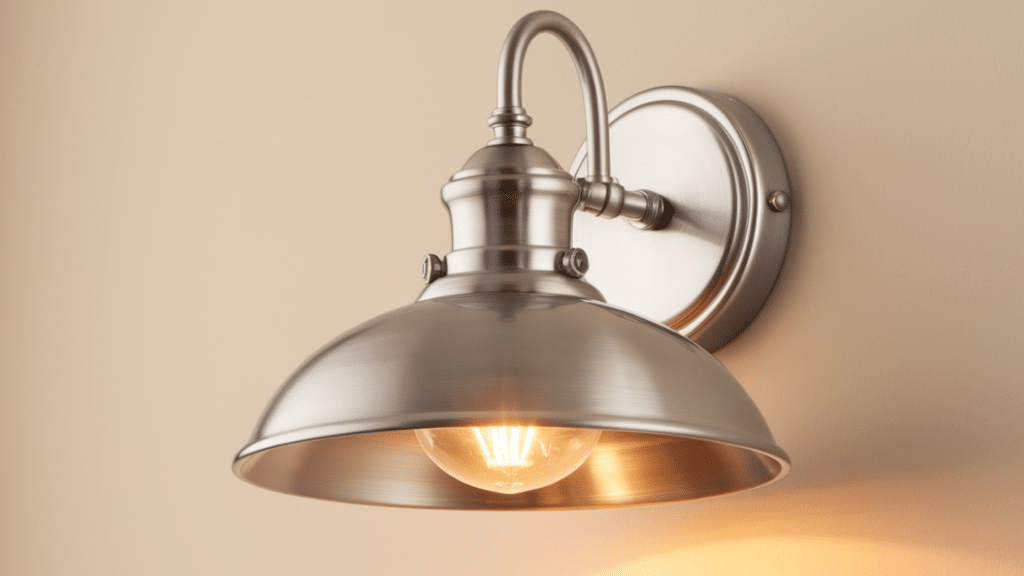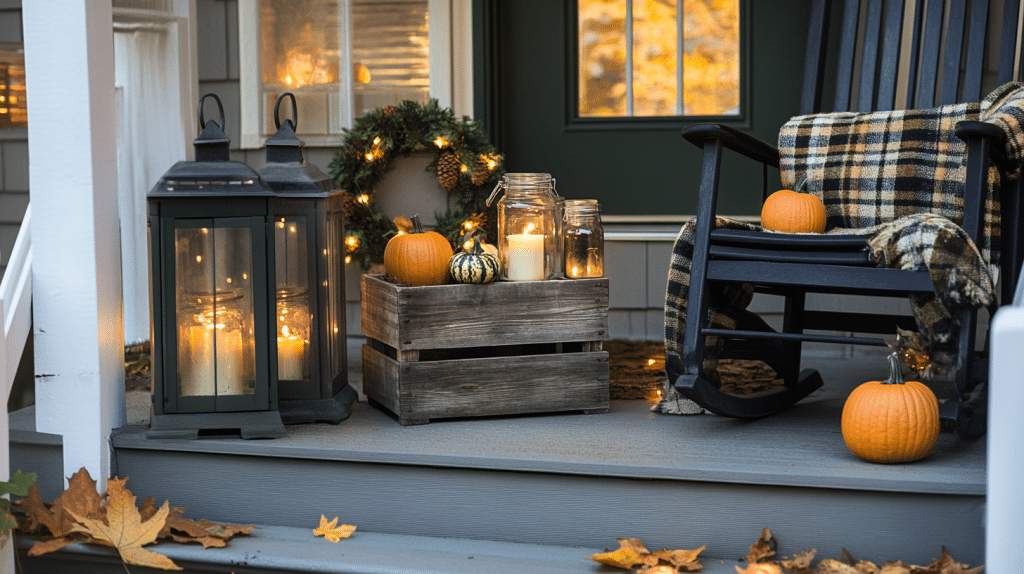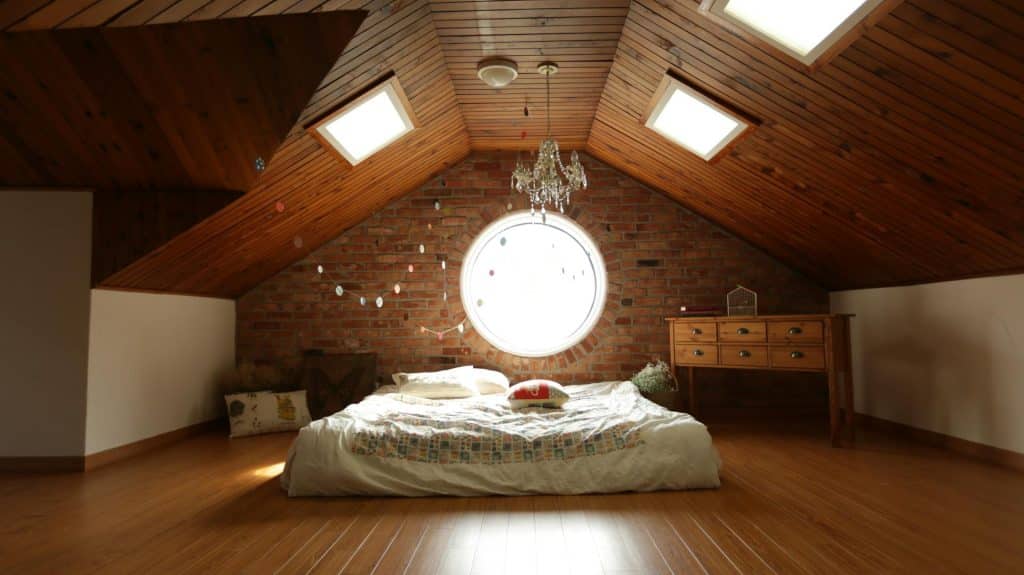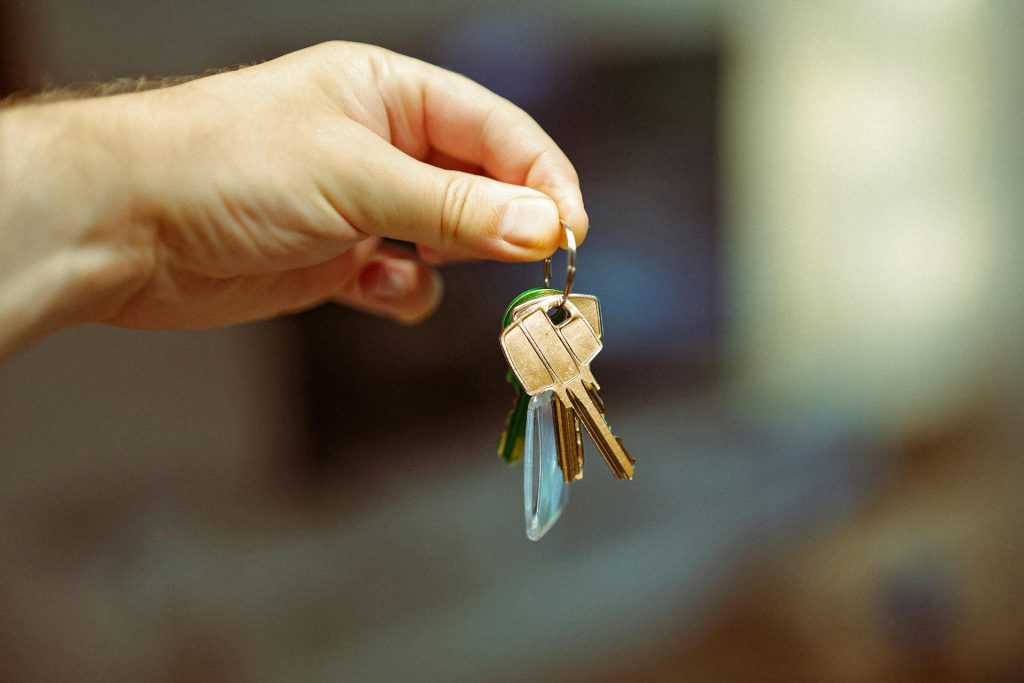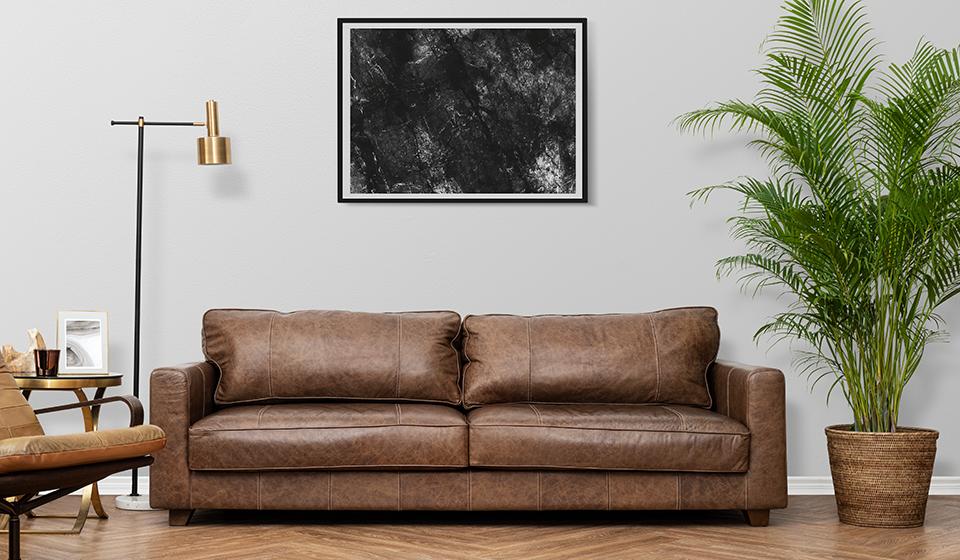Have you ever stood in the hardware store, completely bewildered by the endless metal finish options? I know I have.
Satin nickel catches my eye every time, but what exactly is this popular finish, and how does it stack up against other choices for your home?
This stylish matte silver-gray finish offers a subtle refinement that works beautifully in most spaces. But before you commit to satin nickel for your door handles, cabinet pulls, or bathroom fixtures, you’ll want to understand how it compares to similar finishes like brushed nickel, chrome, and stainless steel.
Let me walk you through everything you need to know about satin nickel, including the main question: what color is satin nickel, to help you make the perfect choice for your home.
What is Satin Nickel?
Satin nickel is a popular metal finish created by applying a nickel coating to a base metal, then brushing it to achieve its signature soft, matte appearance.
Unlike its shinier cousins, this finish undergoes a specialized process that deliberately tones down the reflectiveness, giving it that polished, understated look that’s become a staple in modern homes.
The base metal can vary- often brass, zinc, or steel but it’s the nickel plating and subsequent brushing technique that creates the consistent appearance we recognize. This versatile finish strikes a perfect balance between completely flat and overly shiny, with a subtle luster that catches light gently rather than reflecting it harshly.
What makes satin nickel particularly appealing is its forgiving nature. It hides fingerprints and water spots better than glossier finishes, making it practical for high-traffic areas like kitchens and bathrooms where handles and fixtures see constant use.
Identifying Satin Nickel Color in Home Decor
When I’m trying to spot satin nickel in home decor, I look for its distinctive soft silver-gray color with a subtle warmth underneath.
It’s not completely cool-toned like chrome or stainless steel, often carrying a hint of warmth that makes it blend beautifully with various color schemes. This versatile finish sits comfortably between metallic silver and light gray on the color spectrum.
The surface texture is another giveaway. If you’re wondering what color is satin nickel, its smooth but slightly brushed appearance plays a big role in the answer. It diffuses light instead of reflecting it sharply, creating a gentle glow rather than a mirror-like shine you’d see with polished chrome. Run your finger across it, and you’ll feel a silky smoothness with a very subtle texture.
In natural daylight, satin nickel takes on a refined glow that highlights its brushed texture. The finish appears more muted and graceful compared to shinier metals, giving fixtures a contemporary yet timeless appeal.
When shopping, remember that different manufacturers may have slight variations in their satin nickel finishes. Some lean slightly warmer or cooler, so it’s always wise to bring a sample when matching existing pieces in your home.
How to Decide on Satin Nickel Color: Key Pros and Cons
Before committing to satin nickel for your home, I’ve found it helpful to weigh the advantages and disadvantages of this popular finish.
Here’s what my experience has taught me about this versatile metal option.
Pros:
- Fingerprints and water spots are less visible compared to shinier finishes like chrome.
- Offers exceptional durability when properly applied, often lasting for many years.
- Coordinates effortlessly with most design styles, from traditional to contemporary.
- Provides a versatile neutral that pairs well with virtually any color palette.
- Maintain a consistent look throughout your home for cohesive design.
- Requires minimal maintenance, just occasional wiping with a soft cloth.
- Ages gracefully without dramatic tarnishing or discoloration.
- Creates a polished look without the flashiness of highly polished finishes.
Cons:
- Usually costs more than basic finishes like polished brass or chrome.
- It can be difficult to match exactly across different manufacturers.
- May show wear in high-traffic areas over extended periods.
- Cleaning requires gentle products to avoid damaging the finish.
- Not as distinctive or bold as statement finishes like matte black or copper.
- Sometimes looks too “safe” for highly creative or eclectic design schemes.
How Satin Nickel Color Differs from Other Finishes: A Comparison
When choosing hardware finishes for your home, satin nickel is often compared to other finishes like chrome, brass, or brushed nickel.
Here’s a comparison of satin nickel against other common finishes to help you understand the differences:
| Factor | Satin Nickel | Chrome | Brushed Nickel | Polished Brass |
|---|---|---|---|---|
| Appearance | Soft, matte finish with a subtle shine. | High-gloss, reflective, shiny finish. | Soft sheen with a slightly brushed look. | Bright, shiny gold-like finish. |
| Durability | Resistant to scratches and corrosion. | Prone to scratches and water spots. | Durable and resistant to corrosion. | Prone to tarnishing and discoloration. |
| Costs | Mid-range price. | Typically affordable. | Slightly more expensive than satin nickel. | Expensive, especially for high-end finishes. |
| Maintenance | Low maintenance, easy to clean. | Requires frequent cleaning to avoid water spots. | Low maintenance, resistant to fingerprints. | Needs regular polishing to maintain its shine. |
| Finish | Subtle sheen without being glossy. | Shiny and reflective surface. | Brushed texture with a low sheen. | Highly reflective with a warm, golden tone. |
Satin Nickel vs Chrome
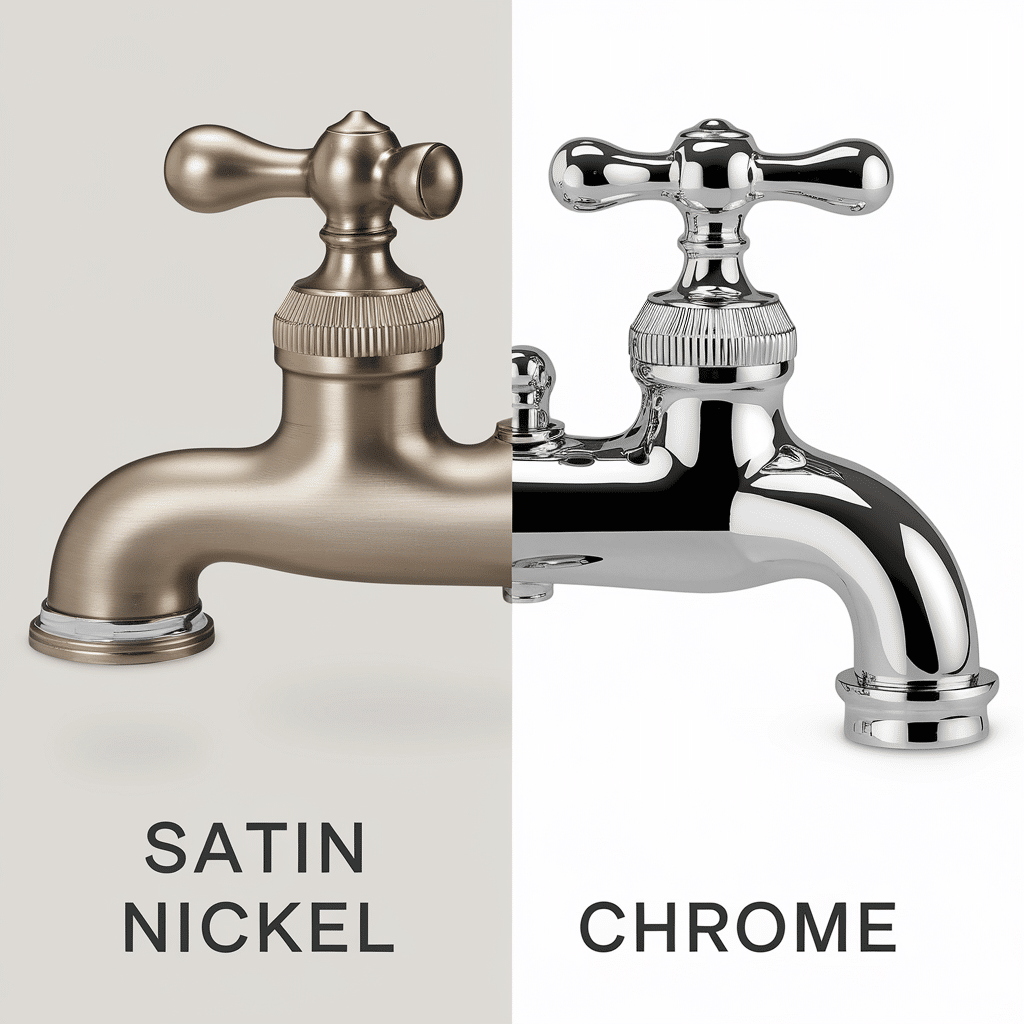
Chrome delivers a mirror-like shine that bounces light around your space, while satin nickel offers a softer, more muted glow.
I’ve noticed chrome feels decidedly modern and can sometimes appear slightly blue-toned, whereas satin nickel brings warmth and versatility. Chrome shows every fingerprint and water spot, making it higher maintenance.
For contemporary spaces that want drama, chrome works beautifully, but for everyday livability with timeless appeal, I always lean toward satin nickel.
Satin Nickel vs Brushed Nickel
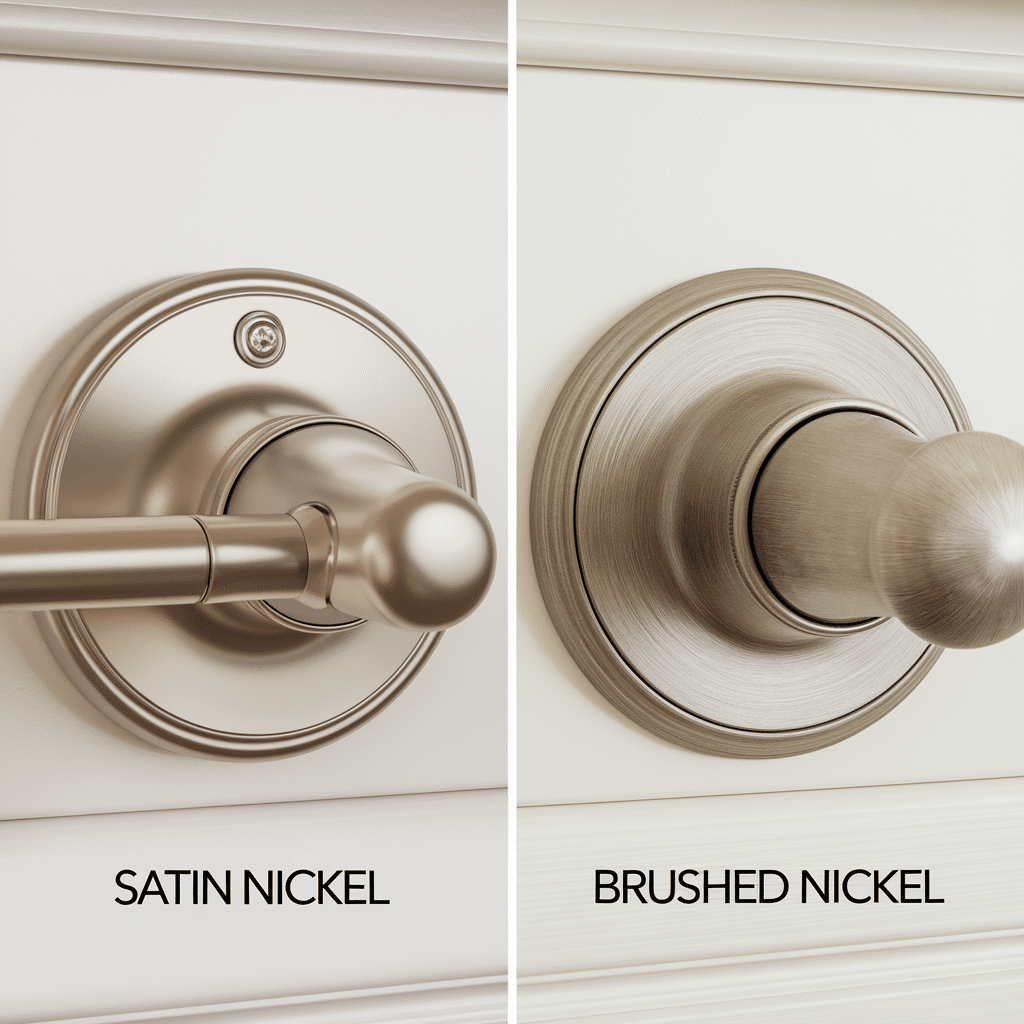
These finishes are close cousins, often causing confusion.
The main difference I’ve found is that brushed nickel typically has a slightly darker, more amber undertone, while satin nickel appears lighter with a more silvery quality. Their brushing techniques also differ slightly; satin nickel generally has a finer, more consistent brush pattern.
Both hide fingerprints well and offer excellent durability, but satin nickel tends to complement cooler color schemes better, while brushed nickel works beautifully with warmer palettes.
Satin Nickel vs Polished Brass
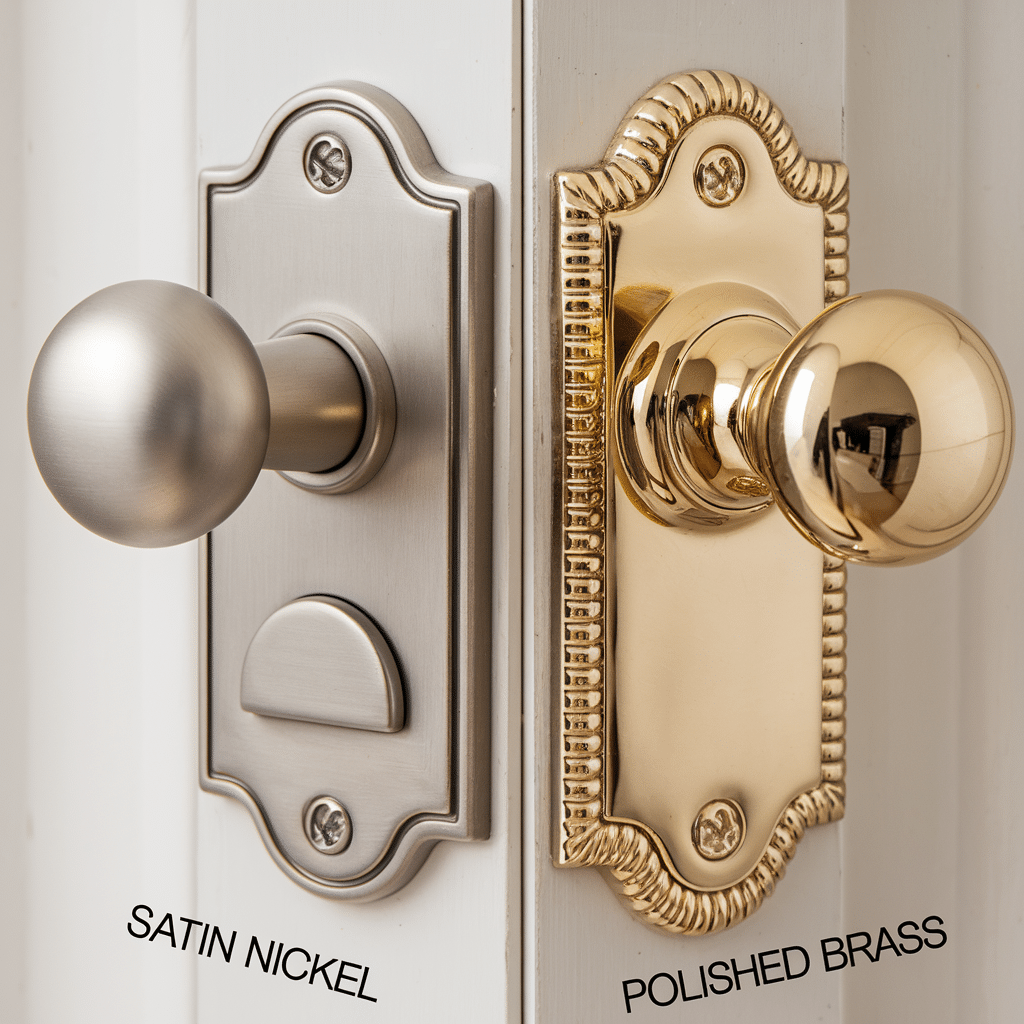
Talk about opposites!
Polished brass delivers that classic golden shine that screams traditional grace, while satin nickel offers contemporary, understated refinement. I’ve found that brass demands attention and becomes a focal point, whereas satin nickel blends harmoniously with surroundings.
Brass requires regular polishing to maintain its luster and tends to show age through patination. Meanwhile, satin nickel stays consistently low-maintenance throughout its lifetime.
The choice often comes down to whether you want your hardware to make a bold statement or provide quiet functionality.
Best Locations for Satin Nickel Accents
I’ve installed dozens of different metal finishes throughout homes over the years, and satin nickel consistently proves to be one of the most versatile.
Its subdued sheen works beautifully in nearly every room without overwhelming your design scheme. If you’re wondering where this popular finish really shines (pun intended!), I’ve found it performs exceptionally well in these key locations. The subtle warmth and muted reflectivity make it perfect for these high-visibility areas where both function and style matter.
Kitchen
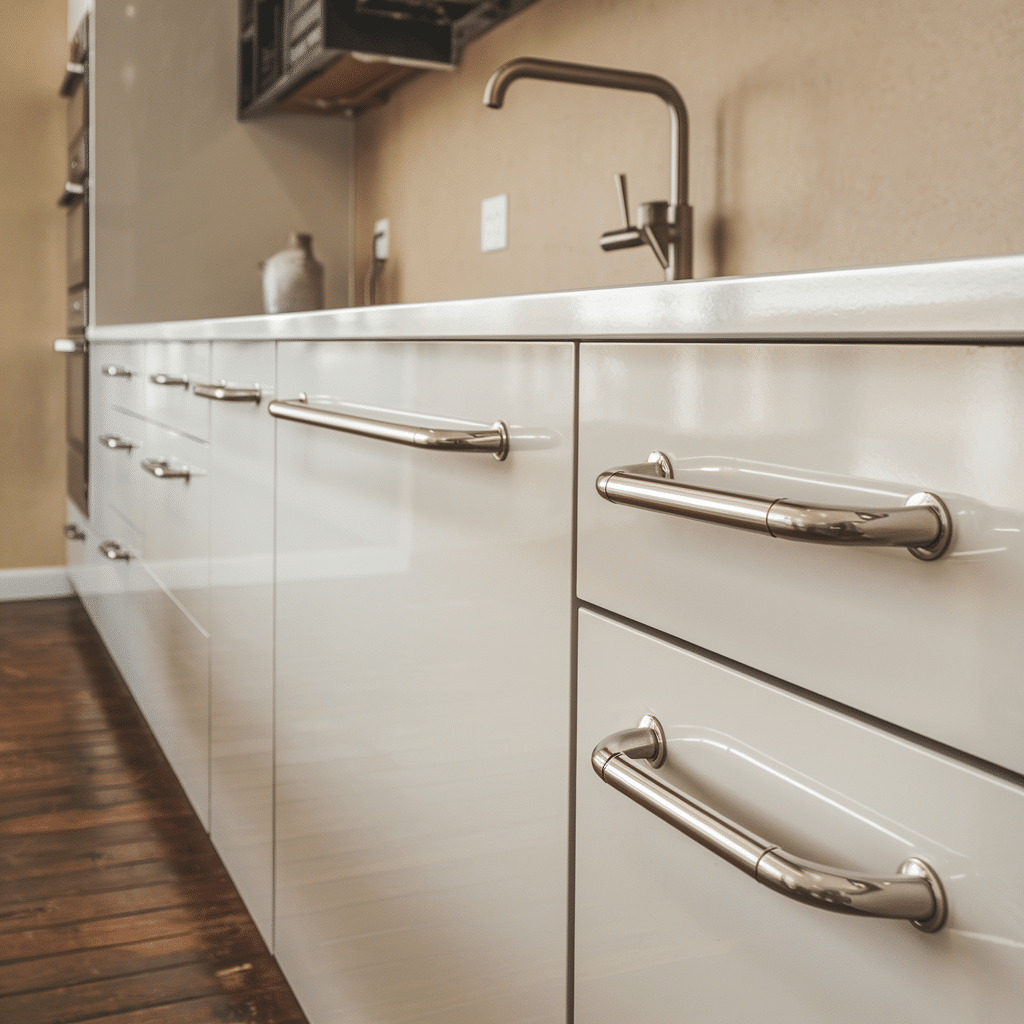
Satin nickel shines in the kitchen, where its fingerprint-resistant finish stands up to constant use. I’ve installed it on cabinet hardware, faucets, and appliance handles with great success.
The subtle sheen complements both light and dark cabinetry while withstanding the inevitable splashes and spills that make glossier finishes a cleaning nightmare.
Bathroom
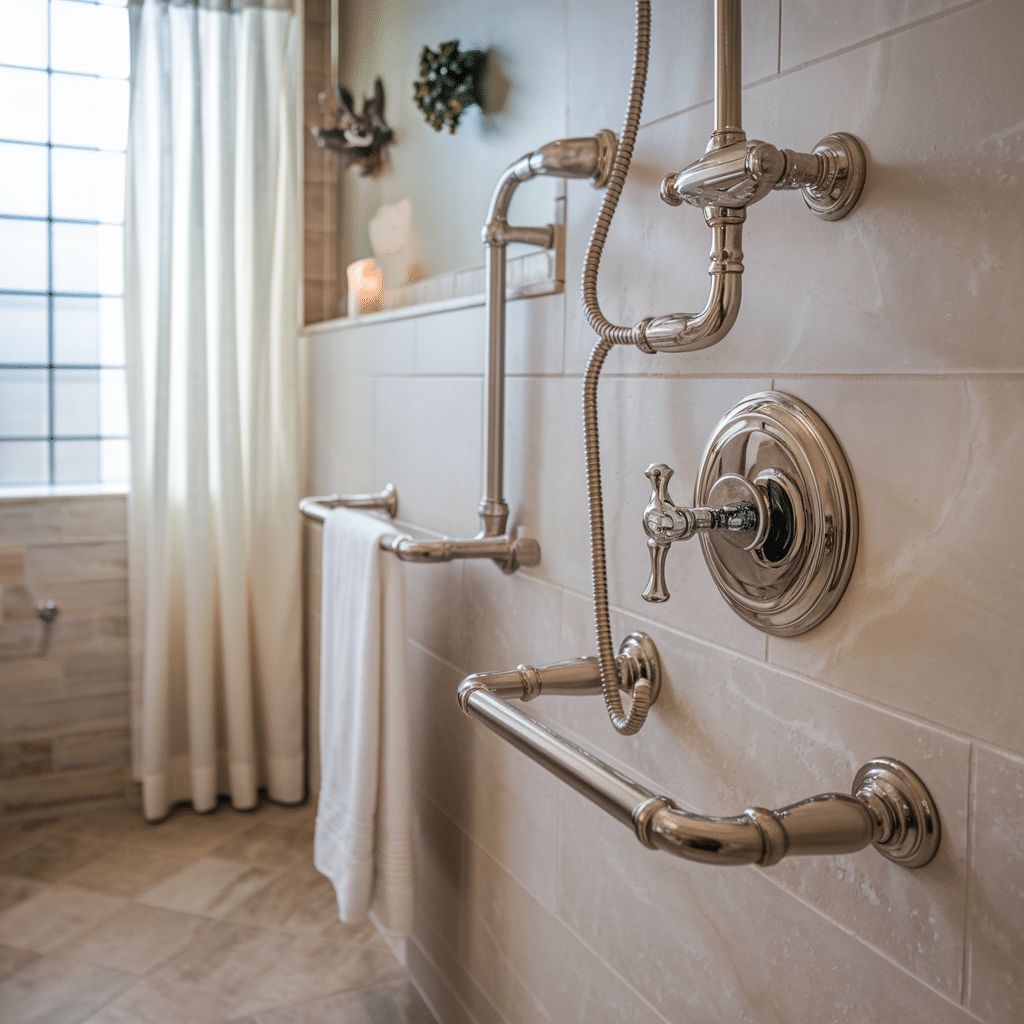
In bathrooms, satin nickel performs beautifully amid humid conditions and frequent water contact.
I love how it looks on faucets, showerheads, towel bars, and cabinet pulls. This finish resists water spots better than chrome and brings a refined touch to the space without competing with other design elements like statement tiles or vanities.
Door Hardware
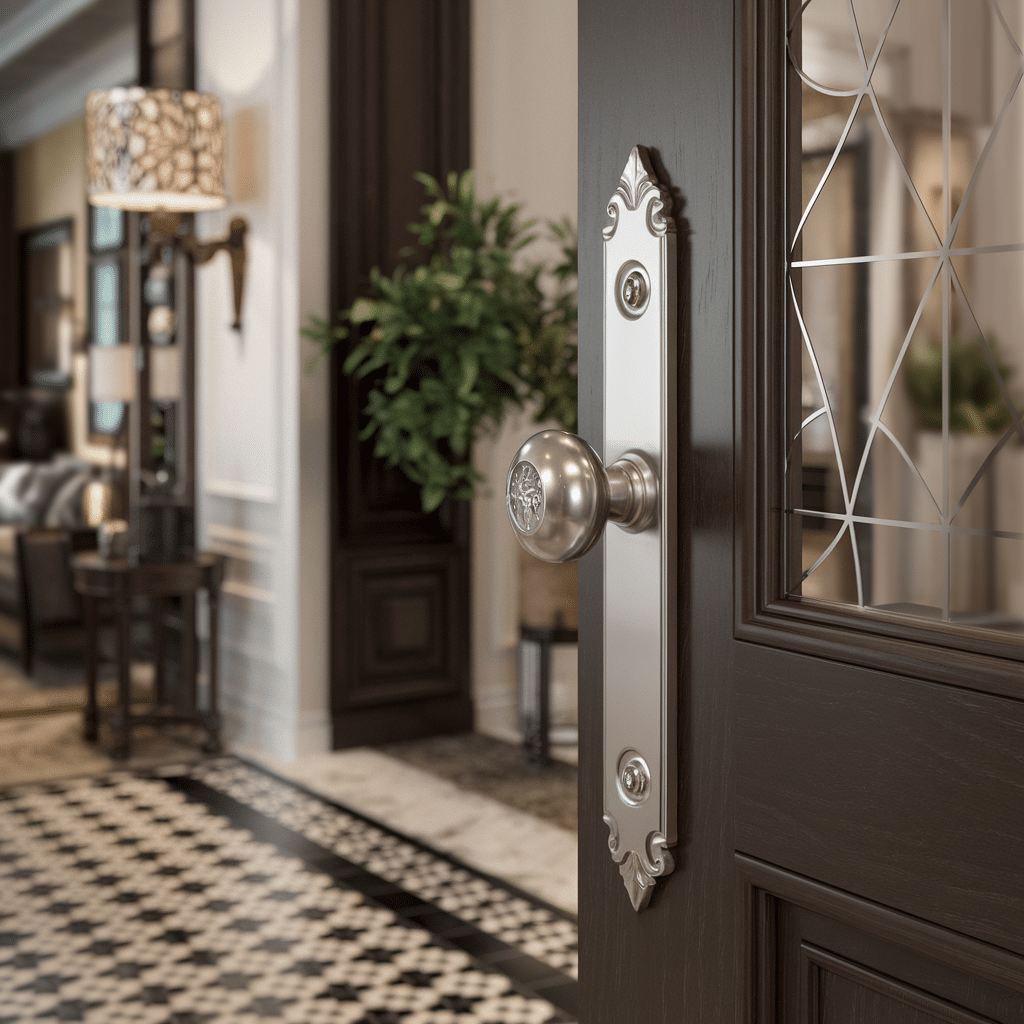
Entry sets, interior doorknobs, and handlesets in satin nickel create a cohesive flow throughout the home.
I’ve found this finish particularly forgiving on high-touch surfaces like doorknobs and lever handles. The subtle warmth works with virtually any wall color or door style, making it perfect for connecting different design themes across rooms.
Light Fixtures
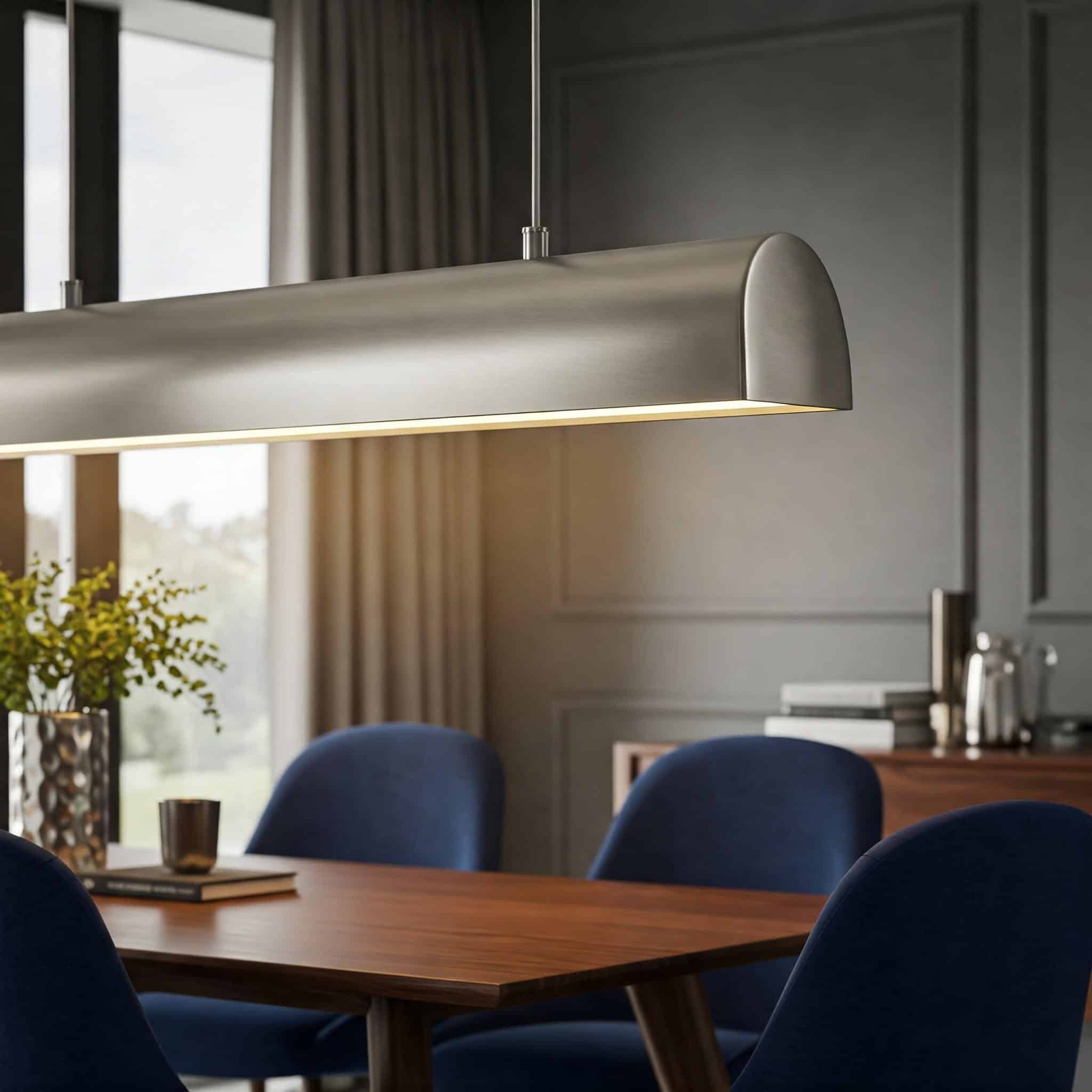
Pendant lights, chandeliers, and sconces in satin nickel add dimension without overwhelming the eye. I particularly appreciate how this finish diffuses light subtly rather than creating harsh reflections.
It works wonderfully in dining areas, hallways, and bedrooms, where you want fixtures that enhance rather than dominate the space.
Furniture Accents
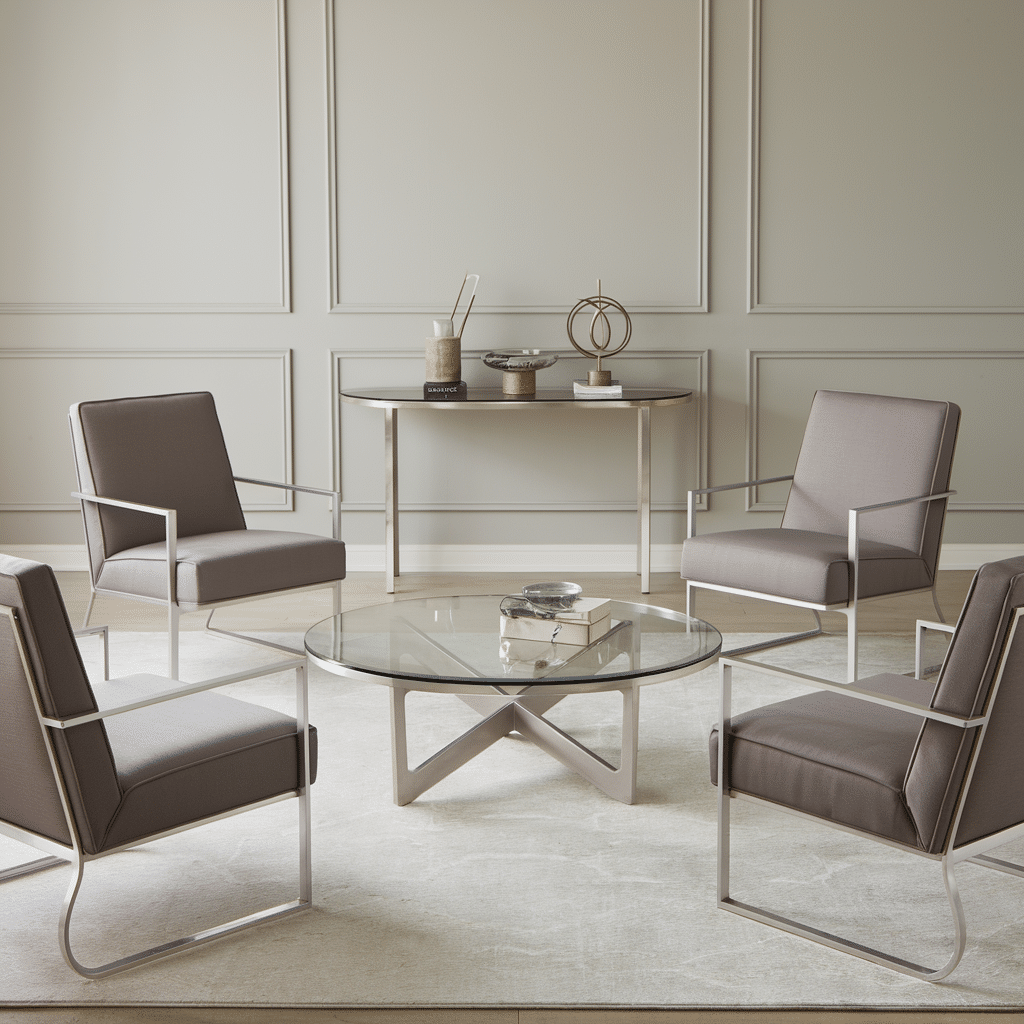
Coffee table frames, chair legs, and decorative furniture hardware benefit from satin nickel’s versatility. I’ve seen it beautifully integrated into both contemporary and transitional pieces. The finish provides just enough metallic interest without the flashiness that can make furniture feel dated or trend-specific.
Whether you’re doing a complete renovation or just updating a few accents, satin nickel delivers that perfect finishing touch. Remember to maintain consistency throughout connected spaces for a cohesive look that feels intentional and professionally designed.
Appearance of Satin Nickel Color Based on Lighting
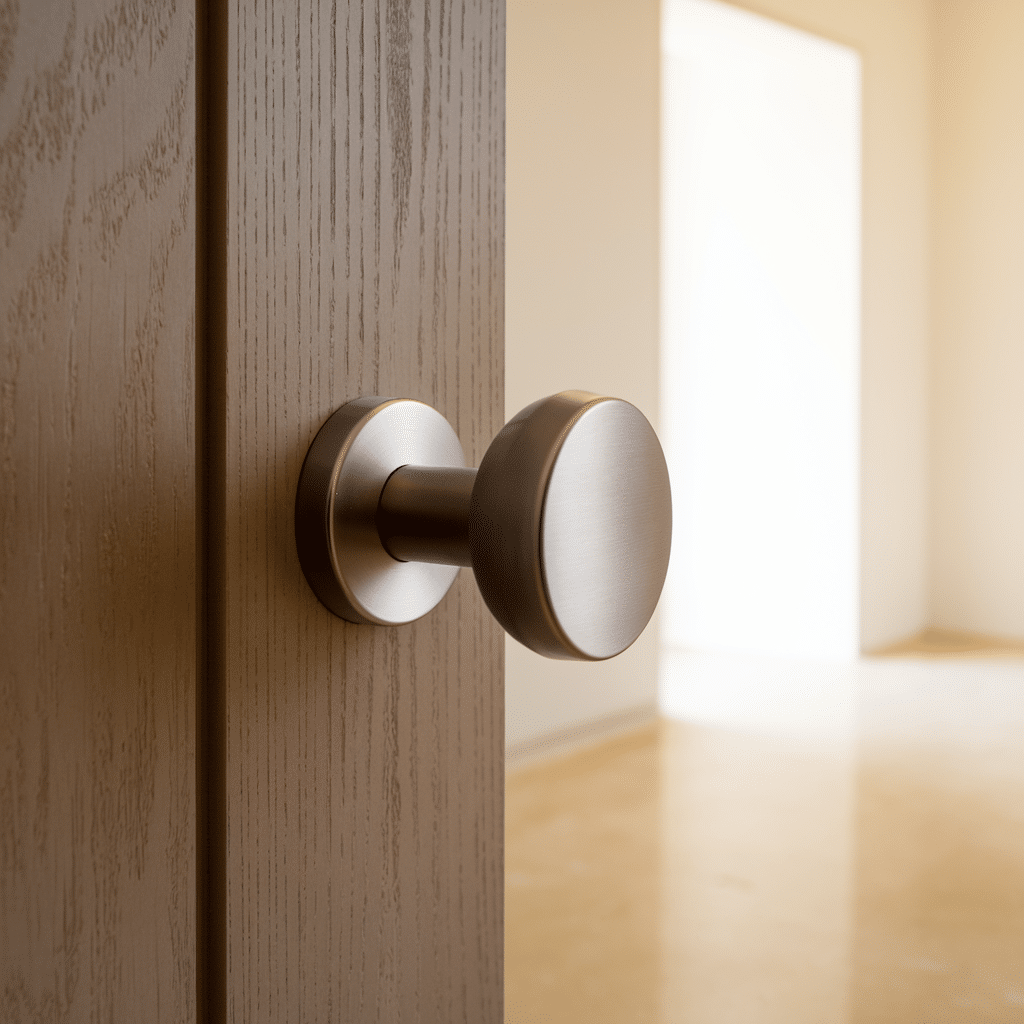
I’ve noticed that the answer to what color is satin nickel can vary subtly depending on the lighting conditions, which makes it such a versatile and interesting finish for home fixtures and hardware.
- Natural Light: Takes on a soft, silvery-gray appearance with its brushed texture becoming more pronounced. The finish appears warmer during the golden hour and cooler under midday sunlight, showcasing its chameleon-like quality.
- Artificial Light: Under standard overhead lighting, satin nickel maintains its muted metallic appearance but may appear slightly flatter. Warm-toned bulbs (2700K-3000K) enhance its warmth, while cooler bulbs (4000K+) emphasize its silver tones.
- Accent Lighting: When illuminated by strategic accent lights, the brushed texture creates subtle, graceful shadows that add dimension. This directed lighting can highlight the craftsmanship of the finish, especially on larger fixtures.
- Evening Hours: In dimmer, evening lighting, satin nickel recedes slightly but maintains enough reflectivity to remain visible. It appears softer and less defined, creating a gentle metallic presence rather than a sharp contrast.
- Bright Spaces: In well-lit, bright rooms, the finish appears more consistent and true to its intended color. The subtle brush lines become more visible, and the overall effect is crisp and clean without being flashy.
The lighting-responsive nature of satin nickel is precisely what makes it such a popular choice for homes with varying light conditions throughout the day.
Maintaining Satin Nickel Color Fixtures: Must-Know Tips
Through years of experience, I’ve learned that proper care is the secret to keeping satin nickel fixtures looking their best. With these simple maintenance practices, your hardware can maintain its subtle luster for decades.
1. Daily Wipe-Down: For frequently used fixtures like faucets and door handles, a quick wipe with a soft, dry microfiber cloth removes fingerprints and prevents buildup. This thirty-second habit prevents most stubborn cleaning issues down the road.
2. Gentle Cleansers Only: Never use abrasive cleaners or scrubbers on satin nickel. I stick to mild soap and water or specific metal-safe cleaners, avoiding anything containing ammonia, bleach, or vinegar, which can damage the finish over time.
3. Proper Drying Technique: After cleaning with any moisture, thoroughly dry fixtures with a soft cloth to prevent water spots, which can be particularly visible on satin finishes. Follow the grain of the brushed texture for best results.
4. Protective Waxing: Once every 3-6 months, consider applying a thin layer of carnauba wax designed for metal finishes. This creates a protective barrier against moisture and oils without affecting the matte appearance.
5. Address Water Spots Immediately: In bathrooms and kitchens, water spots can develop quickly. I keep a soft cloth nearby to wipe fixtures after use, particularly in areas with hard water.
6. Avoid Chemical Contact: Keep hairsprays, perfumes, and cleaning chemicals away from satin nickel surfaces, as the overspray can cause spots or discoloration that’s difficult to remove.
With minimal effort and these straightforward techniques, your satin nickel fixtures will remain a beautiful, subtle accent in your home for years to come, avoiding the replacement costs that come with neglected hardware.
Wrapping It Up
Now that we’ve scouted the world of satin nickel together and found out what color is satin nickel, you can make an informed decision about incorporating this versatile finish into your home. This stylish middle-ground between flashy chrome and warm brass offers both practical durability and timeless style.
Whether you’re renovating your entire home or simply updating a few fixtures, satin nickel provides that perfect balance of refinement without shouting for attention. Its adaptability to different lighting conditions and relatively low maintenance requirements make it a smart choice for busy households.
Ready to modify your space with satin nickel accents? Start small with cabinet hardware or door handles if you’re hesitant, or go bold with matching fixtures throughout connected spaces.
Share your satin nickel projects in the comments. I’d love to see how you’ve incorporated this classic finish!


